-----------------------------------------------------
-----------------------------------------------------
Pythagorean Year Zero
-----------------------------------------------------
-----------------------------------------------------
-----------------------------------------------------
introduction
-----------------------------------------------------
First, I'll need to establish a little groundwork as a brief introduction for those to whom this material is entirely new. So, to begin with, I'll show some examples of the work upon which my own research has been based, and then, following this, I'll present the crux of my own material. So, first, onto the background research. I'll cross-reference the following to other, more detailed research papers available on my site, and only define them here as briefly as necessary.
First, let's establish the skeletal basis for the diagram I've been working with.

To break this image down and make it easier to understand, what we're looking at is simple: the twelve constellations of the zodiac arranged in a circle around the seven planets, displayed as the parallel red lines. The zodiac is labeled in green, and the seven planets in red.
Now, this diagram I originally drew as a means of depicting the chart given by Francis Barrett, a 16th century magician and astrologer. Here's the original chart:
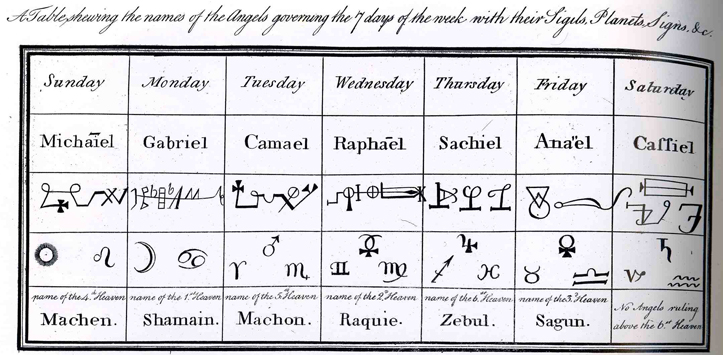
The project I was working on at the time involved the "Kamea," or the magic number squares attributed to the seven astrological planets, according to medieval alchemists, originally by ancient Sumerian scribes. For more information on this project, and to find out more about the above two diagrams, please consult: chart 1. All of this was immediately preceding my ceremonial work "for the zohar" and can be found in the "magick" pages directory from the main page of my site. The following elaborates a little on the beginning of the working for the zohar.
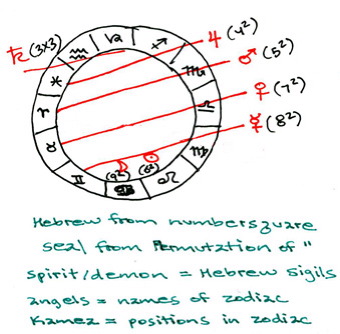
The key to reading the above chart shows, simply, how the circle is divided by six parallel lines, and the final portion divided by another line. The last two portions represent the sun and moon.
However, according to Aleister Crowley, a magician and QBLHist of the early 20th century, there is another way to view the zodiac than from above or below it directly, and that is edge-on, from the side. When we do this, Crowley suggested, it is easiest to visualise when depicted using the interior "dual twist" Gordian knot cross-section of a torus, a shape which resembles Crowely's diagram of same:
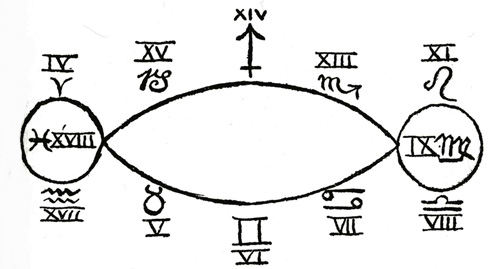
Thus, the transform of topology for the above arrangement, in which the circular zodiac is transected across its interior by six parellel and one perpindicular lines, representing the seven astrological planets, is rendered according to Crowley's design, thus:

Here, we see the red lines represent the planets, and the green labels the zodiac.
Now, we know that, due to the precession of earth's rotation on its axis, since it is inclined 23.5° from its orbital plane, the sun will rise in an earlier and earlier sign (according to their order of rising per year relative our rotation) at the same point in its orbit every 2000 years. We call this precession of the equinoxes the cycle of solar aeons. So, according to the months of the year, Taurus follows Aries. However according to precession, every 2000 years, Aries follows Taurus. And this is true regardless of which hemisphere one is in, the north or the south. However, in depicting the precession of the solar ages from a fixed time, such as at an equinox or solstice, when earth is at perihelion or aphelion in its elliptical orbit, we find that whether one is in the north or south hemisphere determines whether to depict the signs in lunar (north-hemisphere clockwise, south hemisphere counter-clockwise) or solar (north-hemisphere counter-clockwise, south hemisphere clockwise) order. In the diagram above left we see the zodiac arranged such that Spring Equinox is justified to the left, that Autumn Equinox is justified to the right, that Summer Solstice has the upper-position, while Winter Solstice is in the foreground. We are looking at the zodiac from the point of view of the southern hemisphere. We also see that the above diagram incorporates the numbered years per each solar aeon, such that we find the original arrangement of Barrett, its topolgy transformed according to Crowley, is third from the top of the list above. The original diagram represents a time when the planets ruled over a certain arrangement of the zodiac, and we find this arrangement occured for certain specific dates when measured according to the precession of the solar aeons. This concludes my introduction regarding the material of my research. ----------------------------------------------------- historical background ----------------------------------------------------- "The world is indebted to [Pythagoras] for the word 'philosopher.' Before that time, the wise men had called themselves 'sages,' which was interpreted to mean 'those who know.' Pythagoras was more modest. He coined the term 'philosopher,' which he defined as 'one who is attempting to find out.'." - source: Hall, Manly Palmer, 33°. "The Secret Teachings of All Ages." chapter 13. "The philosophical school of Pythagoras was, in a measure, also a series of initiations, for he caused his pupils to pass through a series of degrees and never permitted them personal contact with himself until they had reached the higher grades. According to his biographers, his degrees were three in number. The first, that of 'Mathimaticus,' assuring his pupils proficiency in mathematics and geometry, which was then, as it would be now if Masonry were properly inculcated, the basis upon which all other knowledge was erected. Secondly, the degree of 'Theoreticus,' which dealt with superficial applications of the exact sciences, and lastly, the degree of 'Electus,' which entitled the candidate to pass forward into the light of the fullest illumination which he was capable of absorbing." - source: Higgins, Frank C., 32°. "Ancient Freemasonry." (ref. in Hall, ch. 13) "The Essenes were advocates of the Greek philosopher Pythagoras (c.570-500 BC), who in his great study of arithmetical ratios searched for meaning both in the physical and metaphysical worlds through mathematical porportions. Over the centuries using his methodology, world events were foretold with surprising accuracy. One particular event so forecast was the beginning of a new World Order, an occurance that was in many quarters determined to be the advent of the Saviour Messiah. The years (which we now designate BC) were thus already on a predetermined countdown long before Jesus was born.... Much later, by way of a new Roman dating system, the notional year 0 was designated AD 1." - source: Gardner, Laurence. "Bloodline of the Holy Grail," chapter 5, section 2. Without getting into the religio-political quagmire of the historical period surrounding this "notional" year zero, it should only briefly be mentioned that the year that Pythagoras had predicted as the year zero was not only at a point between two solar aeons, but at one that occured for an equivalent solar "equinox" or mid-season point. For the "notional" year zero, this solar "equinox" marked the seasons of mid-spring for the southern hemisphere, and mid-autumn for the north. ----------------------------------------------------- primary research ----------------------------------------------------- To refer back to the original diagram, the circle of twelve around the six parallel and one perpendicular lines, we can see now that it is set to a solar aeon prior to the "notional" year zero, which marked the solar equinox. Here we see it: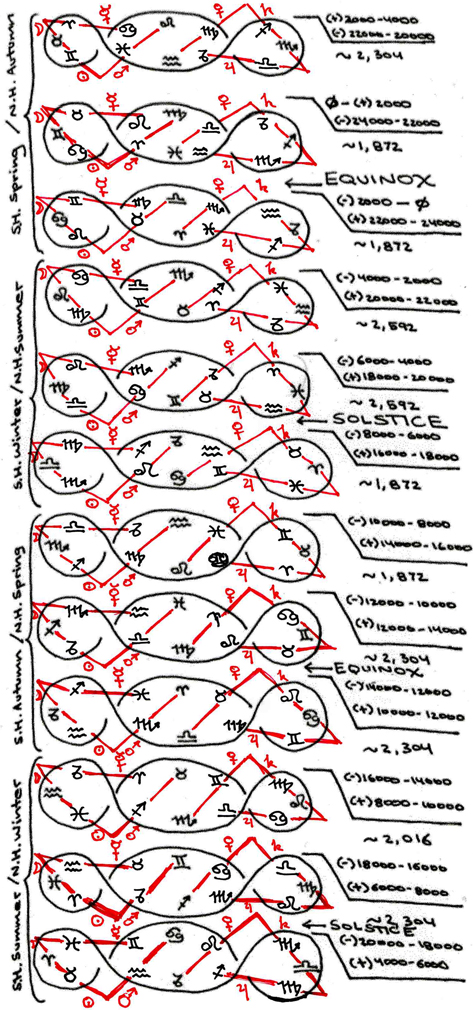

However, if we were to recalibrate this cosmic clock to match the date immediately following the beginning of year zero, such that the solar equinox on the zodiac were reflected as the measurement of the Spring Equinox in the year zero, we would render the following:
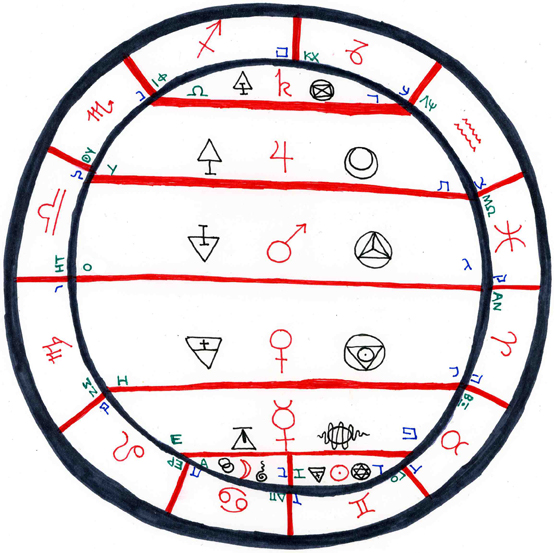
So, now, rather than being set to the solar aeon before and ending in year zero, what we are looking at here is the clock set 2000 years ahead, to the morning of the Spring Equinox, Pythagorean year zero, in either the northern or the southern hemisphere. We see that the zodiac rotates clockwise, and that the point of Spring Equinox on the zodiac for the 2000 year solar aeon beginning in the year zero is marked by the juncture between sun and moon in the planetary parallel lines.
Further represented in this diagram are the relative Greek letters (in green), Hebrew letters (in blue), chakras (black on right) and metals (black on left) that correspond to each planet and sign of the zodiac. All of this is calibrated as an alignment occuring during the "notional" year zero, on the morning of Spring Equinox, in both the northern and southern hemisphere.
-----------------------------------------------------
preliminary applications
-----------------------------------------------------
We're about to deal much more thoroughly with this date, Spring Equinox of Pythagorean year zero, with the next few diagrams, so let's consider what it consists of for a moment more. We see the exterior circle of zodiac signs rotates clockwise, such that the date of the Spring Equinox, between the sun and moon signs, would have just finished being in Cancer, and is just about to enter into a new aeon, when sunrise on the Spring Equinox occurs under the sign of Gemini.
Likewise, all the other seasonal signs shift one down their cyclic elliptic ecliptic. In the same way Spring Equinox is moving from Cancer into Gemini, so too is Summer Solstice moving from Libra into Virgo, and Autumn Equinox moving from Capricorn to Saggitarius, and so too Winter Solstice is moving from Aries into Pisces. Such was the shape of the sky in Pythagorean year zero.
By aligning the signs of the zodiac in their position on Spring Equinox on year zero to a calendar marking the durations of the solar aeons, we find the rising sign on Spring Equinox for every solar aeon. Thus, we can now call the aeons by various names, such that we have, for Spring Equinox, 12 signs, for Autumn Equinox, 12 signs, and 24 for both the Soltices combined. Each of these represents one of twelve different ways to calibrate the calendar.
This calendar is calibrated to Spring Equinox, and the year zero is set to the same position, at the lowest base of the circle, between the waning sign of Cancer and the waxing sign of Gemini.
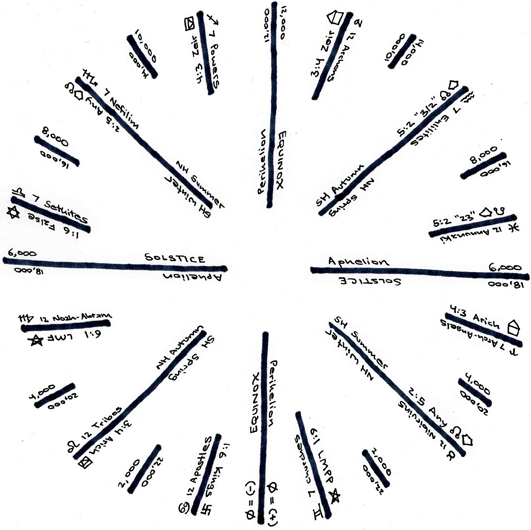
Here we see the "notional" year zero clearly marked as an Equinox, and as a Perihelion, or point when the earth is closest to the sun. The other points of alignment mark off aeons both 6,000 and 12,000 years before and after Pythagorean Year Zero. The above diagram is called the "Lemurian Calendar" which I discuss at length in a blog on my ~GOD~ myspace "music" page, also available in non-commentable form here: the Lemurian Calendar.
-----------------------------------------------------
primary application
-----------------------------------------------------
The main application of the "year zero" diagram of my primary research here, that is, the "barred-circle" motif based on Barrett's chart, corrected to Spring Equinox of Pythagorean Year Zero, is to the Atlantean Calendar. If the Lemurian Calendar is a gnomonic sundial, measuring off as 24 labels the 12 basic stations of the zodiac, then the Atlantean Calendar is a Swiss grandfather clock with thousands of miniscule and intricate cogs and gears. The Atlantean Calendar measures seconds per minute (i ching to zodiac), minutes per day (zodiac to tzolkin), days per week (tzolkin to planets), weeks per month (planets to haab), months per year (haab to total calendar round), however, if one looks at all of this from a few levels even further back, we can see that each zodiac sign measures a solar aeon of 2000 years each, and so the entire mechanism measures precession.
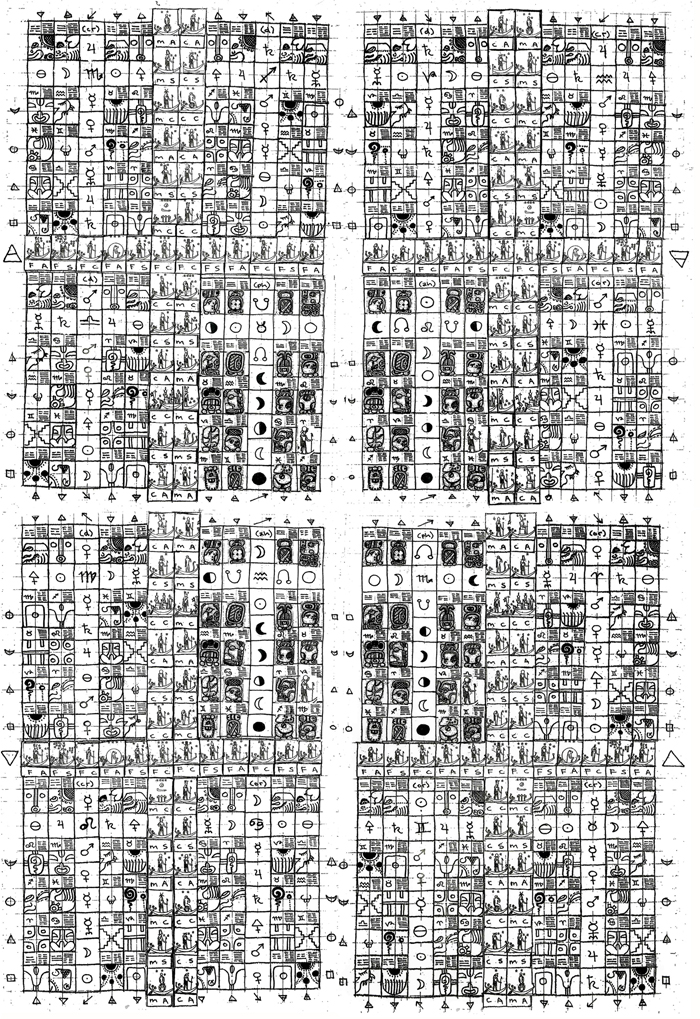
Now what we're looking for here are the twelve signs of the zodiac at the crux of the tweleve surrounding calvary crosses. Observe these are positioned the same in the Atlantean calendar as they are in the Lemurian Calendar. Likewise, the seven ruling planets can be seen depicted above these crux signs, at the heads of the same calvary crosses.
Therefore, what we can survey from this purview, is that the Atlantean Calendar is calibrated to Spring Equinox (between Cancer and Gemini in the lower center) of Year Zero, when year zero is plotted by the spring equinox on a calendar marking the dates of durations per solar aeon. In other words, the Atlantean Calendar, the Lemurian Calendar, and the recalibrated "barred circle" motif based on Barrett.
We should take note here that, from this perspective on the Atlantean Calendar, as being based from Spring Equinox on Pythagorean Year Zero, the zodiac precesses counter-clockwise, however the interior 4 quadrants of the Haab revolve clockwise.
More cannot be said yet at this time.
-----------------------------------------------------
-----------------------------------------------------
